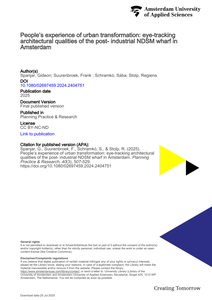Urban densification continues unabated, even as the possible consequences for users’ eye-level experiences remain unknown. This study addresses these consequences. In a laboratory setting, images of the NDSM wharf were shown to university students primed for one of three user groups: residents, visitors and passers-by. Their visual experiences were recorded using eye-tracking and analyzed in combination with surveys on self-reported appreciation and restorativeness. On-site surveys were also administered among real users. The results reveal distinct eye-movement patterns that point to the influence of environmental roles and tasks and how architectural qualities steer people’s visual experience, valence and restoration.
DOCUMENT

Large cities in the West respond to an ever-increasing shortage of affordable housing by accelerating the process of urban densification. Amsterdam, for instance, aims to increase its housing stock by 10 percent in the next 15 years as its population is expected to grow by 20 percent. As in other cities, it seems inevitable that high-rise buildings with higher skyscrapers than in the past will be built within the existing urban fabric. Such large-scale (re)development projects shape the conditions for inhabitants’ eye-level experiences, perception of place and overall well-being. The new hybrid field of neuroarchitecture offers promising eye-tracking technology and theories for measuring inhabitants’ visual experiences of the city and rethinking the effectiveness of applied design principles across the globe. In this paper, the ‘classic’ design solutions for creating streetscapes on a human scale in densified areas have been assessed by eye-tracking 31 participants in a laboratory setting, all of whom viewed photographs of 15 existing streetscapes in high-rise environments. The study drew on theories from the field of neuroarchitecture and used input from a panel of (landscape) architects and urban designers to design the research and analyze the eye-tracked patterns. The results indicate that the classic design principles (horizontal–vertical rhythms and variety; active ground floor; tactile materials) play a significant role in people’s appreciation of the streetscape and that their attention is unconsciously captured by the presence of these principles. The absence of the design principles seems to result in a scattered ‘searching’ eye movement pattern. This also suggests that a coherent design of streetscapes in high-rise environments may contribute to a human scale at eye-level.
MULTIFILE
Currently, 4% of older adults reside in long-term care facilities in the Netherlands. Nursing home residents tend to have multimorbidity that is associated with considerable disabilities and a high level of care dependency. In the Dutch adult population the highest estimated prevalence (>40%) of visual impairment (low vision and blindness) was found in the subgroup of residents in nursing homes (NHs). The aim of this study is to describe the current practice of eye care by Dutch nursing home physicians (NHPs). A digital online survey was developed to describe the eye care activities of nursing home physicians and their cooperation in this perspective with other professionals. Of 1573 NHPs present in the Netherlands, 125 (8%) responded. Results show that more than 50% of the NHPs regularly examine ‘distant vision’, ‘near vision’ and ‘the visual field’ . However, 23%, 33% and 45% almost never or never examine the ‘visual field’, ‘near vision’ and ‘distant vision’, respectively. Data regarding eye care, regularly recorded in the client files by more than 50% of the NHPs, are medical data involving ‘use of eye medication’, ‘eye disease’, and ‘eye surgery in the past’. Less commonly recorded is ‘the use of reading glasses’ as well as ‘eye pain’. Inside of the NH, (head) nurses and ward nurses (chi 2 = 309, df = 5, p = 0.000), and outside of the NH, ophthalmologists and low vision specialists are most frequently contacted about eye related issues (chi 2 = 224, df = 4, p = 0.000). Opticians are rarely contacted, and optometrists and orthoptists are ‘never’ contacted by more than 50% of the NHPs. Moreover, 50% of the NHPs noted that collaboration with external eye care professionals is ‘not structural’. This study shows that, according to NHPs, relevant visual aspects are not structurally examined and recorded in the client files. Outside of the NH, NHPs tend to have a less frequent collaborative relationship with optometrists, orthoptists and opticians compared to ophthalmologists and low vision specialists. The NHP’s role in providing eye care can be improved by development of guidelines for structural eye screening, improvement of recording in client files, and exploring plus undertaking collaboration with other eye care professionals.
LINK